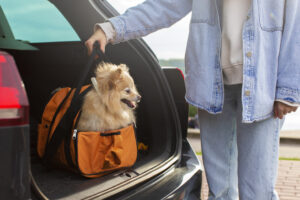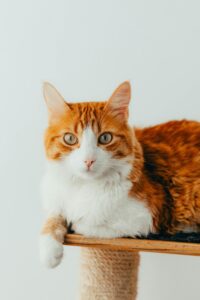Traveling with Pets for stress-free journey
Traveling with pets can be a rewarding experience, but it also requires careful planning to ensure a smooth journey for both you and your furry friend.
1. Stress-Free Pet Travel: Pre-Trip Prep for a Smooth Journey:

b. Ensuring your pet’s identification: Proper identification for your pet is crucial. Ensure they have both a microchip and a collar with an ID tag. The ID tag should include your name, phone number, and any other relevant contact information. This ensures that if your pet ever gets lost, they can be easily reunited with you. Additionally, regularly check that the microchip information is up-to-date and the collar is secure and in good condition. For more information on pet identification, check out this comprehensive guide on pet safety.
c .Acclimate Your Pet to Travel: If your pet isn’t accustomed to traveling, start by taking them on short car rides to help them get used to the experience. Gradually increasing the duration of these trips can help reduce anxiety during longer journeys. Make sure to create a comfortable environment in the car, with their favorite blanket or toy, and consider using a pet seatbelt or carrier for safety. Additionally, offer positive reinforcement, such as treats and praise, to create a positive association with car travel. This gradual approach will help ensure your pet remains calm and comfortable on longer trips.
2. Packing Essentials for Pets: Ensure a Stress-Free Journey

a. Food and Water: To ensure your pet stays healthy and comfortable during the trip, bring enough of their regular food to last the entire journey. Pack portable water bowls and plenty of bottled water to keep them hydrated. It’s important to maintain their usual diet, as sudden changes can lead to stomach upset and digestive issues.
b. Comfort Items: Pack your pet’s favorite toys, blankets, or bedding to provide comfort and a sense of familiarity during the trip. Items that carry familiar scents can help reduce anxiety and stress in unfamiliar environments. Ensuring your pet has these comforting items can make a significant difference in their overall well-being and behavior while traveling.
c. Medications: If your pet requires medication, ensure you have enough for the duration of the trip. Keep a copy of the prescription and a first aid kit handy. For more information on pet travel safety, visit the American Veterinary Medical Association and the Centers for Disease Control and Prevention.
d. Travel Carrier: Select a sturdy, well-ventilated carrier that is appropriately sized for your pet. It’s essential that your pet can stand up, turn around, and lie down comfortably within the carrier. Ensuring the carrier meets these criteria will provide your pet with a safe and comfortable space, reducing stress during travel. For additional tips on choosing the right carrier, visit the American Society for the Prevention of Cruelty to Animals (ASPCA).
3. Traveling by Car with Pets: Tips for a Stress-Free Journey

a. Safety First: Never let your pet roam freely in the car. Use a pet seatbelt, carrier, or travel crate to keep them secure. This ensures their safety and prevents distractions while driving.
b. Regular Breaks: Plan for regular stops every 2-3 hours to allow your pet to stretch, relieve themselves, and have some water. Always use a leash during breaks to prevent your pet from running off.
c. Temperature Control: Never leave your pet alone in a parked car, especially in extreme temperatures. Even with the windows cracked, temperatures can rise quickly and be dangerous.
4. Air Travel with Pets: Tips for a Stress-Free Journey

a. Research airline policies: When planning to travel with your pet, it’s crucial to be aware that each airline has its own set of policies and requirements for pet travel. These policies can vary significantly, so it’s important to thoroughly research the specific guidelines of the airline you will be using. Key aspects to consider include the requirements for pet carriers, the necessity of health certificates, and any additional fees that may apply.
b. Choose Direct Flights: Whenever possible, it is highly recommended to choose direct flights for your pet’s travel. Opting for direct flights can significantly reduce the stress associated with layovers and transfers. Layovers can extend the total travel time, increasing the duration your pet spends in unfamiliar and potentially stressful environments.
Why Direct Flights are Best for Pet Travel: Tips for a Stress-Free Journey:
- Reduced Transit Time: Direct flights minimize the overall time your pet spends in transit. This is especially beneficial for pets that may become anxious or stressed during travel. Shortening the travel time can help maintain their comfort and well-being.
- Less Handling and Movement: With layovers and transfers, there is more handling and movement of your pet and their carrier. This increases the chances of mishandling, misplacement, or accidents. Direct flights reduce the number of times your pet’s carrier is moved, ensuring a smoother journey.
- Decreased Risk of Delays and Complications: Layovers can introduce the risk of delays, missed connections, and other complications that can prolong the travel experience. Direct flights help mitigate these risks, providing a more predictable and controlled travel environment for your pet.
- Consistency in Environment: Direct flights ensure that your pet remains in a consistent environment for the duration of the journey, without the need to adjust to multiple different surroundings. This stability can be comforting and reduce travel-related anxiety.
By prioritizing direct flights, you can help ensure that your pet has a more comfortable and less stressful travel experience. The less time your pet spends in transit, the better their overall well-being during the journey.
5. Accommodation Planning: Ensuring a Stress-Free Trip with Pets:

a. Pet-Friendly Lodging: When planning a trip with your pet, it’s essential to research and book pet-friendly accommodations well in advance. Although many hotels, motels, and vacation rentals welcome pets, each establishment has its own set of policies and restrictions. To ensure a smooth and enjoyable stay, it’s best to confirm these pet policies before your arrival.
Booking Pet-Friendly Stays: Tips for a Stress-Free Journey:
- Start Your Search Early: Begin looking for pet-friendly accommodations as soon as you start planning your trip. Popular pet-friendly options can fill up quickly, especially during peak travel seasons. Early booking ensures you have a wider selection of places to choose from.
- Confirm Pet Policies: Even if an accommodation is listed as pet-friendly, it’s important to verify their specific policies. Contact the hotel or rental directly to confirm details such as pet fees, breed and size restrictions, and the number of pets allowed per room. Some places may have additional requirements, such as proof of vaccinations or a pet deposit.
- Consider Amenities and Services: Look for accommodations that offer amenities and services catering to pets. These might include designated pet areas, walking trails, pet-sitting services, and special pet amenities like beds, bowls, and treats. Such features can make your stay more comfortable and enjoyable for both you and your pet.
- Read Reviews: Check online reviews from other pet owners to get a sense of their experiences at the accommodations you’re considering. Reviews can provide valuable insights into the friendliness of the staff, cleanliness of the property, and overall suitability for pets.
- Prepare for House Rules: Some accommodations may have specific house rules for pets, such as not allowing pets on furniture, requiring pets to be crated when left alone, or restricting pets from certain areas of the property. Make sure you understand and are prepared to adhere to these rules to avoid any issues during your stay.
- Have a Backup Plan: Occasionally, unexpected issues may arise with your chosen accommodation. It’s a good idea to have a list of alternative pet-friendly places nearby in case you need to make last-minute changes to your plans.
By taking these steps to research and book pet-friendly accommodations in advance, you can ensure a comfortable and welcoming environment for your pet throughout your trip. This preparation helps to avoid any surprises and allows you to focus on enjoying your vacation with your furry companion.
b. Pet-Proof the Space: Upon arriving at your destination, it’s essential to pet-proof the area to ensure it is safe and secure for your pet. Taking a few moments to assess and modify the environment can prevent potential hazards and give you peace of mind during your stay.
Steps to Pet-Proof Your Accommodation:
- Inspect for Hazardous Items: Carefully check the room or rental for any items that could pose a danger to your pet. Look for small objects, such as coins, paper clips, or batteries, that a pet could swallow. Secure or remove any sharp items, electrical cords, or toxic substances like cleaning supplies and medications.
- Check for Escape Routes: Thoroughly inspect the area for potential escape routes. Ensure that doors and windows are securely closed and that screens are intact. If you have an outdoor space, check the perimeter for gaps or weak spots in fences or walls where your pet might slip through.
- Remove Tempting Items: Pets are naturally curious and may be tempted to explore unfamiliar objects. Remove or secure items like trash cans, food, and personal belongings to prevent your pet from accessing them. Keep bags, luggage, and shoes out of reach to avoid chewing or ingestion of harmful materials.
- Secure Cords and Wires: Pets can easily get tangled in or chew on electrical cords and wires, posing a risk of injury or electrical shock. Use cord organizers or cover them with protective tubing to keep them out of reach.
- Set Up a Safe Space: Create a designated safe space for your pet where they can feel comfortable and relaxed. This area can include their bed, toys, and familiar items from home. Having a consistent and familiar space helps reduce anxiety and gives your pet a sense of security.
- Block Off Restricted Areas: If there are areas of the accommodation where you don’t want your pet to go, use baby gates or closed doors to restrict access. This can help prevent accidents and keep your pet in a safe and controlled environment.
- Check for Hidden Dangers: Look under furniture, behind curtains, and in nooks and crannies for any hidden hazards. Ensure that all furniture is stable and that there are no small spaces where your pet could get stuck.
By taking these steps to pet-proof your accommodation upon arrival, you can create a safe and welcoming environment for your pet. This proactive approach helps prevent accidents and allows both you and your pet to enjoy a stress-free stay.
Maintaining Your Pet’s Routine: Tips for Stress-Free Travel:
- Stick to Regular Feeding Times: Try to feed your pet at the same times you do at home. Maintaining their usual feeding schedule helps regulate their digestion and prevents any potential stress-related digestive issues. Pack enough of their regular food to last the entire trip to avoid any sudden dietary changes.
- Maintain Walking and Exercise Routines: Ensure your pet gets their usual amount of exercise and outdoor time. If your pet is used to morning and evening walks, try to stick to this schedule. Research pet-friendly parks or walking trails near your accommodation so your pet can enjoy their walks in a safe and stimulating environment.
- Keep to Sleeping Patterns: Mimic your pet’s regular sleeping environment as closely as possible. Bring along their bed, blanket, or favorite sleeping spot to help them feel more at home. Try to stick to their usual bedtime routine, whether it involves a short walk, some playtime, or quiet time together.
- Familiar Playtimes: If your pet has regular playtimes or specific activities they enjoy at certain times of the day, incorporate these into your travel schedule. Bringing along their favorite toys or engaging in familiar games can help reduce stress and keep them entertained.
- Use Comforting Items: Bring along items that have familiar scents, such as their favorite blanket or a piece of clothing from home. These items can provide comfort and reassurance in a new environment.
- Monitor for Stress Signs: Pay attention to any signs of stress or anxiety in your pet. Changes in behavior, appetite, or bathroom habits can indicate that they are feeling unsettled. Adjust your routine as needed to help them feel more comfortable.
- Stay Flexible: While it’s important to maintain routines, also be flexible and patient. Travel can be unpredictable, and sometimes adjustments need to be made. The key is to balance consistency with adaptability to ensure your pet’s well-being.
By maintaining your pet’s regular feeding, walking, and sleeping schedule as much as possible, you provide them with a sense of familiarity and stability. This consistency helps reduce anxiety and ensures that your pet remains happy and healthy throughout your travels.
6. During the Trip: Ensuring a Stress-Free Journey with Pets
a. Stay Calm: Pets are highly attuned to their owners’ emotions and can easily pick up on feelings of stress, anxiety, or calmness. Staying calm and relaxed yourself is essential for helping your pet feel more at ease in unfamiliar or stressful situations.
How Your Emotions Impact Your Pet: Tips for a Stress-Free Travel Experience:
- Emotional Sensitivity: Pets, especially dogs and cats, are incredibly sensitive to their owners’ emotional states. They can sense changes in your tone of voice, body language, and overall demeanor. If you are feeling anxious or stressed, your pet is likely to pick up on these cues and may become anxious as well.
- Setting the Tone: Your behavior sets the tone for your pet’s experience. By remaining calm and composed, you provide a reassuring presence that helps your pet feel secure. Take deep breaths, speak in a soothing voice, and maintain relaxed body language to convey a sense of calm.
- Consistency and Reassurance: Pets thrive on consistency and routine. By staying calm and maintaining a consistent routine, you help provide a sense of normalcy. Offer your pet reassurance through gentle petting, kind words, and familiar routines to help them feel more comfortable.
- Managing Your Stress: It’s important to manage your own stress levels, especially when traveling or encountering new situations. Practice stress-relief techniques such as deep breathing, meditation, or mindfulness exercises. Your calm demeanor will have a positive impact on your pet’s emotional state.
- Positive Reinforcement: Use positive reinforcement to reward your pet’s calm behavior. Treats, praise, and affection can help reinforce a sense of security and relaxation. This positive feedback loop encourages your pet to remain calm and composed.
- Creating a Calm Environment: Ensure that the environment around you and your pet is as calm and quiet as possible. Minimize loud noises, sudden movements, and chaotic situations. Creating a peaceful atmosphere helps both you and your pet stay relaxed.
- Preparation and Planning: Being well-prepared for your trip or any new experience can help reduce your own stress, which in turn benefits your pet. Plan ahead, pack necessary items, and familiarize yourself with pet-friendly places and activities. Knowing that you have everything under control will help you stay calm and confident.
By staying calm and relaxed, you create a positive and reassuring environment for your pet. Your emotional state directly influences your pet’s well-being, so maintaining your composure is key to helping them feel more at ease in any situation.
b. Monitor Your Pet: Monitoring your pet’s behavior and well-being throughout your trip is essential to ensure they remain healthy and comfortable. Being attentive to your pet’s needs and recognizing signs of stress or discomfort can help you address issues promptly and keep your pet happy during your travels.
Tips for Monitoring Your Pet’s Well-Being During Stress-Free Travel:
- Observe Body Language: Keep a close eye on your pet’s body language for any signs of stress or anxiety. Look for cues such as tucked tails, flattened ears, pacing, or restlessness. These signals can indicate that your pet is feeling uneasy.
- Watch for Physical Symptoms: Be alert to physical symptoms that may indicate stress or discomfort. Common signs include excessive panting, drooling, trembling, or dilated pupils. If you notice any of these symptoms, try to identify and eliminate the source of stress.
- Monitor Appetite: Changes in your pet’s eating habits can be a sign of stress or illness. If your pet is eating significantly less or more than usual, it may indicate that they are feeling anxious or unwell. Ensure they have access to their regular food and fresh water at all times.
- Check for Excessive Grooming or Shedding: Over-grooming or increased shedding can be a response to stress. If you notice your pet licking, biting, or scratching themselves excessively, it may be a sign that they are feeling anxious or uncomfortable.
- Notice Changes in Bathroom Habits: Pay attention to any changes in your pet’s bathroom habits, such as increased frequency, accidents, or diarrhea. These changes can be stress-related and may require a calming environment or a visit to the veterinarian.
- Provide Breaks and Exercise: Ensure your pet gets regular breaks to stretch, exercise, and relieve themselves. Regular exercise helps reduce stress and keeps your pet physically and mentally healthy. Schedule breaks during long car rides or flights to allow your pet to move around and relax.
- Create a Comforting Environment: Bring along familiar items such as your pet’s bed, toys, and blankets to create a sense of home. A comforting and familiar environment can help reduce anxiety and keep your pet calm.
- Stay Attuned to Vocalizations: Unusual vocalizations, such as whining, barking, or meowing, can be a sign of distress. Pay attention to any changes in your pet’s vocal behavior and respond with reassurance and comfort.
- Consult a Veterinarian: If you notice any persistent signs of stress or if your pet’s behavior changes significantly, consult a veterinarian. They can provide guidance on managing stress and ensuring your pet’s health during the trip.
By keeping a vigilant eye on your pet’s behavior and well-being, you can quickly address any issues that arise and ensure a more comfortable and enjoyable experience for your furry companion. Recognizing and responding to signs of stress helps maintain your pet’s health and happiness throughout your journey.
c. Be Prepared for Emergencies: Familiarize yourself with the locations of the nearest veterinary clinics both along your travel route and at your destination. Having this information at your fingertips can be crucial, potentially saving valuable time and ensuring swift medical attention in the event of an emergency. Being prepared can make all the difference for your pet’s well-being.”
Conclusion
Traveling with pets can be a joyful experience with the right preparation and mindset. By taking the necessary steps to ensure your pet’s safety and comfort, you can enjoy a stress-free journey and create wonderful memories together. Whether you’re exploring new places or visiting loved ones, your pet will appreciate the adventure as much as you do.
Fact findings:For comprehensive guidelines and tips on traveling with pets, visit the American Veterinary Medical Association (AVMA) Pet Travel Safety page.
Thanks for reading and have a great day! Sure! How about this:Do you find traveling with your pet stressful?
please post your thoughts in the comments section if you have any.please feel free to share!

